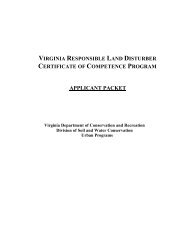Invasive Alien Plant Species of Virginia Hydrilla (Hydrilla verticillata)
Invasive Alien Plant Species of Virginia Hydrilla (Hydrilla verticillata)
Invasive Alien Plant Species of Virginia Hydrilla (Hydrilla verticillata)
Create successful ePaper yourself
Turn your PDF publications into a flip-book with our unique Google optimized e-Paper software.
<strong>Invasive</strong> <strong>Alien</strong> <strong>Plant</strong> <strong>Species</strong> <strong>of</strong> <strong>Virginia</strong><br />
<strong>Hydrilla</strong> (<strong>Hydrilla</strong> <strong>verticillata</strong>)<br />
<strong>of</strong> plant parts. The plant forms<br />
dense clumps <strong>of</strong> vegetation that<br />
can clog boat propellers and impede<br />
navigation, shade light<br />
from beneficial plants, provide<br />
habitat for noxious insects such<br />
as mosquitoes, clog water intakes,<br />
and remove oxygen from<br />
the water as dead plant matter<br />
decays.<br />
Control<br />
Accurate identification <strong>of</strong> hydrilla<br />
by a resource specialist<br />
should precede control efforts. If<br />
a new site is discovered, it<br />
should be reported to appropriate<br />
<strong>of</strong>ficials. Because <strong>of</strong> the great<br />
economic impact <strong>of</strong> this noxious<br />
weed, control efforts have been<br />
heavily researched and widely<br />
applied. These efforts include<br />
chemical control through herbicides,<br />
biological control using<br />
introduced natural predators, and<br />
mechanical harvesting and destruction<br />
efforts. Studies have<br />
identified effective chemicals,<br />
but there are concerns about<br />
their impact on the environment.<br />
Biological control organisms<br />
studied include insects, grass<br />
carp, snail species, manatees,<br />
and fungi species. Grass carp,<br />
an exotic fish species, can be effective,<br />
but may become a pest<br />
themselves. Mechanical harvesting<br />
will reduce infestations in<br />
the short term and are used to<br />
keep waterways and marinas<br />
open. However, if the fragments<br />
are not contained, they can also<br />
float away and establish new<br />
colonies elsewhere.<br />
For more information on native<br />
plant conservation, contact<br />
the <strong>Virginia</strong> Native <strong>Plant</strong> Society<br />
at the address below. For information<br />
on <strong>Virginia</strong>'s natural areas<br />
and natural heritage resources,<br />
contact the <strong>Virginia</strong> Department<br />
<strong>of</strong> Conservation and<br />
Recreation's Division <strong>of</strong> Natural<br />
Heritage (see address below).<br />
Written with assistance from<br />
Ruth Douglas and Laura Peters<br />
at <strong>Virginia</strong> Polytechnic and<br />
State University.<br />
Illustration from Field Guide to<br />
Coastal Wetland <strong>Plant</strong>s <strong>of</strong> the Southeastern<br />
United States, by Ralph Tiner,<br />
University <strong>of</strong> Massachusetts Press.<br />
12/97<br />
For more information, contact the Department <strong>of</strong> Conservation and Recreation or the <strong>Virginia</strong> Native <strong>Plant</strong> Society.<br />
217 Governor Street, Richmond, <strong>Virginia</strong> 23219<br />
(804) 786-7951<br />
http://www.state.va.us/~dcr/vaher.html<br />
<strong>Virginia</strong> Native <strong>Plant</strong> Society<br />
Blandy Experimental Farm<br />
400 Blandy Lane, Unit 2<br />
Boyce, <strong>Virginia</strong> 22620<br />
(540) 837-1600<br />
http://www.vnps.org
















